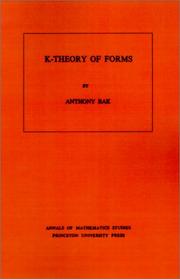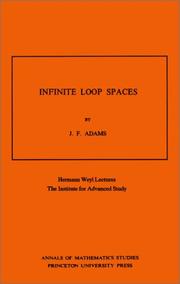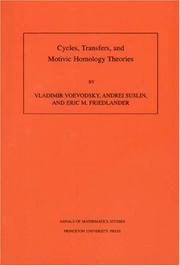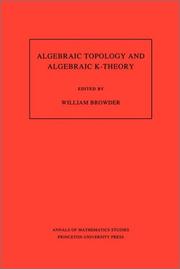| Listing 1 - 8 of 8 |
Sort by
|
Book
ISBN: 1400846528 1299051448 9781400846528 9780691157757 0691157758 9780691157764 0691157766 9781299051447 Year: 2013 Volume: no. 186 Publisher: Princeton, NJ
Abstract | Keywords | Export | Availability | Bookmark
 Loading...
Loading...Choose an application
- Reference Manager
- EndNote
- RefWorks (Direct export to RefWorks)
Since its introduction by Friedhelm Waldhausen in the 1970's, the algebraic K-theory of spaces has been recognized as the main tool for studying parametrized phenomena in the theory of manifolds. However, a full proof of the equivalence relating the two areas has not appeared until now. This book presents such a proof, essentially completing Waldhausen's program from more than thirty years ago. The main result is a stable parametrized h-cobordism theorem, derived from a homotopy equivalence between a space of PL h-cobordisms on a space X and the classifying space of a category of simple maps of spaces having X as deformation retract. The smooth and topological results then follow by smoothing and triangulation theory. The proof has two main parts. The essence of the first part is a "desingularization," improving arbitrary finite simplicial sets to polyhedra. The second part compares polyhedra with PL manifolds by a thickening procedure. Many of the techniques and results developed should be useful in other connections.
Piecewise linear topology. --- Mappings (Mathematics) --- Maps (Mathematics) --- Functions --- Functions, Continuous --- Topology --- Transformations (Mathematics) --- PL topology --- Manifolds (Mathematics) --- CAT Whitehead space. --- CAT manifold. --- Euclidean neighborhood retract. --- Euclidean polyhedra. --- PL Serre fibration. --- PL Whitehead space. --- PL homeomorphism. --- PL manifold. --- Quillen's Theorem A. --- Quillen's Theorem B. --- absolute neighborhood retract. --- algebraic K-theory of spaces. --- algebraic K-theory. --- approximate lifting property. --- cofibration. --- degeneracy operator. --- desingularization. --- finite simplicial set. --- h-cobordism theorem. --- homotopy equivalence. --- homotopy fiber sequence. --- horn. --- manifold space. --- manifold. --- n-manifolds. --- normal subdivision. --- polyhedral realization. --- q-simplex. --- reduced mapping cylinder. --- simple map. --- simplicial set. --- space. --- stabilization map. --- stable parametrized h-cobordism theorem. --- tangent microbundle. --- thickening. --- triangulation. --- weak homotopy equivalence. --- Čech homotopy type.

ISBN: 069108274X 0691082758 1400881412 9780691082752 9780691082745 Year: 1981 Volume: 98 Publisher: Princeton (N.J.): Princeton university press
Abstract | Keywords | Export | Availability | Bookmark
 Loading...
Loading...Choose an application
- Reference Manager
- EndNote
- RefWorks (Direct export to RefWorks)
The description for this book, K-Theory of Forms. (AM-98), Volume 98, will be forthcoming.
Category theory. Homological algebra --- 515.14 --- Algebraic topology --- 515.14 Algebraic topology --- Forms (Mathematics) --- K-theory --- Modules (Algebra) --- Finite number systems --- Modular systems (Algebra) --- Algebra --- Finite groups --- Rings (Algebra) --- Homology theory --- Quantics --- Mathematics --- K-theory. --- Abelian group. --- Addition. --- Algebraic K-theory. --- Algebraic topology. --- Approximation. --- Arithmetic. --- Canonical map. --- Coefficient. --- Cokernel. --- Computation. --- Coprime integers. --- Coset. --- Direct limit. --- Direct product. --- Division ring. --- Elementary matrix. --- Exact sequence. --- Finite group. --- Finite ring. --- Free module. --- Functor. --- General linear group. --- Global field. --- Group homomorphism. --- Group ring. --- Homology (mathematics). --- Integer. --- Invertible matrix. --- Isomorphism class. --- Linear map. --- Local field. --- Matrix group. --- Maxima and minima. --- Mayer–Vietoris sequence. --- Module (mathematics). --- Monoid. --- Morphism. --- Natural transformation. --- Normal subgroup. --- P-group. --- Parameter. --- Power of two. --- Product category. --- Projective module. --- Quadratic form. --- Requirement. --- Ring of integers. --- Semisimple algebra. --- Sesquilinear form. --- Special case. --- Steinberg group (K-theory). --- Steinberg group. --- Subcategory. --- Subgroup. --- Subspace topology. --- Surjective function. --- Theorem. --- Theory. --- Topological group. --- Topological ring. --- Topology. --- Torsion subgroup. --- Triviality (mathematics). --- Unification (computer science). --- Unitary group. --- Witt group. --- K-théorie

ISBN: 0691082073 0691082065 1400821258 Year: 1978 Volume: no. 90 Publisher: Princeton, N.J.
Abstract | Keywords | Export | Availability | Bookmark
 Loading...
Loading...Choose an application
- Reference Manager
- EndNote
- RefWorks (Direct export to RefWorks)
The theory of infinite loop spaces has been the center of much recent activity in algebraic topology. Frank Adams surveys this extensive work for researchers and students. Among the major topics covered are generalized cohomology theories and spectra; infinite-loop space machines in the sense of Boadman-Vogt, May, and Segal; localization and group completion; the transfer; the Adams conjecture and several proofs of it; and the recent theories of Adams and Priddy and of Madsen, Snaith, and Tornehave.
Algebraic topology --- Loop spaces --- Espaces de lacets --- Infinite loop spaces. --- Abelian group. --- Adams spectral sequence. --- Adjoint functors. --- Algebraic K-theory. --- Algebraic topology. --- Automorphism. --- Axiom. --- Bott periodicity theorem. --- CW complex. --- Calculation. --- Cartesian product. --- Cobordism. --- Coefficient. --- Cofibration. --- Cohomology operation. --- Cohomology ring. --- Cohomology. --- Commutative diagram. --- Continuous function. --- Counterexample. --- De Rham cohomology. --- Diagram (category theory). --- Differentiable manifold. --- Dimension. --- Discrete space. --- Disjoint union. --- Double coset. --- Eilenberg. --- Eilenberg–Steenrod axioms. --- Endomorphism. --- Epimorphism. --- Equivalence class. --- Euler class. --- Existential quantification. --- Explicit formulae (L-function). --- Exterior algebra. --- F-space. --- Fiber bundle. --- Fibration. --- Finite group. --- Function composition. --- Function space. --- Functor. --- Fundamental class. --- Fundamental group. --- Geometry. --- H-space. --- Homology (mathematics). --- Homomorphism. --- Homotopy category. --- Homotopy group. --- Homotopy. --- Hurewicz theorem. --- Inverse limit. --- J-homomorphism. --- K-theory. --- Limit (mathematics). --- Loop space. --- Mathematical induction. --- Maximal torus. --- Module (mathematics). --- Monoid. --- Monoidal category. --- Moore space. --- Morphism. --- Multiplication. --- Natural transformation. --- P-adic number. --- P-complete. --- Parameter space. --- Permutation. --- Prime number. --- Principal bundle. --- Principal ideal domain. --- Pullback (category theory). --- Quotient space (topology). --- Reduced homology. --- Riemannian manifold. --- Ring spectrum. --- Serre spectral sequence. --- Simplicial set. --- Simplicial space. --- Special case. --- Spectral sequence. --- Stable homotopy theory. --- Steenrod algebra. --- Subalgebra. --- Subring. --- Subset. --- Surjective function. --- Theorem. --- Theory. --- Topological K-theory. --- Topological ring. --- Topological space. --- Topology. --- Universal bundle. --- Universal coefficient theorem. --- Vector bundle. --- Weak equivalence (homotopy theory). --- Topologie algébrique

ISBN: 0691048142 0691048150 9786613379825 1283379821 140083712X 9780691048147 9780691048154 Year: 2011 Volume: 143 Publisher: Princeton, NJ : Princeton University Press,
Abstract | Keywords | Export | Availability | Bookmark
 Loading...
Loading...Choose an application
- Reference Manager
- EndNote
- RefWorks (Direct export to RefWorks)
The original goal that ultimately led to this volume was the construction of "motivic cohomology theory," whose existence was conjectured by A. Beilinson and S. Lichtenbaum. This is achieved in the book's fourth paper, using results of the other papers whose additional role is to contribute to our understanding of various properties of algebraic cycles. The material presented provides the foundations for the recent proof of the celebrated "Milnor Conjecture" by Vladimir Voevodsky. The theory of sheaves of relative cycles is developed in the first paper of this volume. The theory of presheaves with transfers and more specifically homotopy invariant presheaves with transfers is the main theme of the second paper. The Friedlander-Lawson moving lemma for families of algebraic cycles appears in the third paper in which a bivariant theory called bivariant cycle cohomology is constructed. The fifth and last paper in the volume gives a proof of the fact that bivariant cycle cohomology groups are canonically isomorphic (in appropriate cases) to Bloch's higher Chow groups, thereby providing a link between the authors' theory and Bloch's original approach to motivic (co-)homology.
Bundeltheorie --- Cohomology [Sheaf ] --- Faisceaux [Théorie des ] --- Sheaf cohomology --- Sheaf theory --- Sheaves (Algebraic topology) --- Sheaves [Theory of ] --- Théorie des faisceaux --- Algebraic cycles --- Homology theory --- Algebraic cycles. --- Homology theory. --- Cohomology theory --- Contrahomology theory --- Algebraic topology --- Cycles, Algebraic --- Geometry, Algebraic --- Abelian category. --- Abelian group. --- Addition. --- Additive category. --- Adjoint functors. --- Affine space. --- Affine variety. --- Alexander Grothendieck. --- Algebraic K-theory. --- Algebraic cycle. --- Algebraically closed field. --- Andrei Suslin. --- Associative property. --- Base change. --- Category of abelian groups. --- Chain complex. --- Chow group. --- Closed immersion. --- Codimension. --- Coefficient. --- Cohomology. --- Cokernel. --- Commutative property. --- Commutative ring. --- Compactification (mathematics). --- Comparison theorem. --- Computation. --- Connected component (graph theory). --- Connected space. --- Corollary. --- Diagram (category theory). --- Dimension. --- Discrete valuation ring. --- Disjoint union. --- Divisor. --- Embedding. --- Endomorphism. --- Epimorphism. --- Exact sequence. --- Existential quantification. --- Field of fractions. --- Functor. --- Generic point. --- Geometry. --- Grothendieck topology. --- Homeomorphism. --- Homogeneous coordinates. --- Homology (mathematics). --- Homomorphism. --- Homotopy category. --- Homotopy. --- Injective sheaf. --- Irreducible component. --- K-theory. --- Mathematical induction. --- Mayer–Vietoris sequence. --- Milnor K-theory. --- Monoid. --- Monoidal category. --- Monomorphism. --- Morphism of schemes. --- Morphism. --- Motivic cohomology. --- Natural transformation. --- Nisnevich topology. --- Noetherian. --- Open set. --- Pairing. --- Perfect field. --- Permutation. --- Picard group. --- Presheaf (category theory). --- Projective space. --- Projective variety. --- Proper morphism. --- Quasi-projective variety. --- Residue field. --- Resolution of singularities. --- Scientific notation. --- Sheaf (mathematics). --- Simplicial complex. --- Simplicial set. --- Singular homology. --- Smooth scheme. --- Spectral sequence. --- Subcategory. --- Subgroup. --- Summation. --- Support (mathematics). --- Tensor product. --- Theorem. --- Topology. --- Triangulated category. --- Type theory. --- Universal coefficient theorem. --- Variable (mathematics). --- Vector bundle. --- Vladimir Voevodsky. --- Zariski topology. --- Zariski's main theorem. --- 512.73 --- 512.73 Cohomology theory of algebraic varieties and schemes --- Cohomology theory of algebraic varieties and schemes

ISBN: 0691120439 0691120447 1299133258 1400837170 9780691120430 9781400837175 9780691120447 Year: 2005 Volume: no. 157 Publisher: Princeton Princeton University Press
Abstract | Keywords | Export | Availability | Bookmark
 Loading...
Loading...Choose an application
- Reference Manager
- EndNote
- RefWorks (Direct export to RefWorks)
In recent years, considerable progress has been made in studying algebraic cycles using infinitesimal methods. These methods have usually been applied to Hodge-theoretic constructions such as the cycle class and the Abel-Jacobi map. Substantial advances have also occurred in the infinitesimal theory for subvarieties of a given smooth variety, centered around the normal bundle and the obstructions coming from the normal bundle's first cohomology group. Here, Mark Green and Phillip Griffiths set forth the initial stages of an infinitesimal theory for algebraic cycles. The book aims in part to understand the geometric basis and the limitations of Spencer Bloch's beautiful formula for the tangent space to Chow groups. Bloch's formula is motivated by algebraic K-theory and involves differentials over Q. The theory developed here is characterized by the appearance of arithmetic considerations even in the local infinitesimal theory of algebraic cycles. The map from the tangent space to the Hilbert scheme to the tangent space to algebraic cycles passes through a variant of an interesting construction in commutative algebra due to Angéniol and Lejeune-Jalabert. The link between the theory given here and Bloch's formula arises from an interpretation of the Cousin flasque resolution of differentials over Q as the tangent sequence to the Gersten resolution in algebraic K-theory. The case of 0-cycles on a surface is used for illustrative purposes to avoid undue technical complications.
512.73 --- Cohomology theory of algebraic varieties and schemes --- 512.73 Cohomology theory of algebraic varieties and schemes --- Algebraic cycles. --- Hodge theory. --- Geometry, Algebraic. --- Algebraic geometry --- Geometry --- Complex manifolds --- Differentiable manifolds --- Geometry, Algebraic --- Homology theory --- Cycles, Algebraic --- Algebraic cycles --- Hodge theory --- Addition. --- Algebraic K-theory. --- Algebraic character. --- Algebraic curve. --- Algebraic cycle. --- Algebraic function. --- Algebraic geometry. --- Algebraic number. --- Algebraic surface. --- Algebraic variety. --- Analytic function. --- Approximation. --- Arithmetic. --- Chow group. --- Codimension. --- Coefficient. --- Coherent sheaf cohomology. --- Coherent sheaf. --- Cohomology. --- Cokernel. --- Combination. --- Compass-and-straightedge construction. --- Complex geometry. --- Complex number. --- Computable function. --- Conjecture. --- Coordinate system. --- Coprime integers. --- Corollary. --- Cotangent bundle. --- Diagram (category theory). --- Differential equation. --- Differential form. --- Differential geometry of surfaces. --- Dimension (vector space). --- Dimension. --- Divisor. --- Duality (mathematics). --- Elliptic function. --- Embedding. --- Equation. --- Equivalence class. --- Equivalence relation. --- Exact sequence. --- Existence theorem. --- Existential quantification. --- Fermat's theorem. --- Formal proof. --- Fourier. --- Free group. --- Functional equation. --- Generic point. --- Geometry. --- Group homomorphism. --- Hereditary property. --- Hilbert scheme. --- Homomorphism. --- Injective function. --- Integer. --- Integral curve. --- K-group. --- K-theory. --- Linear combination. --- Mathematics. --- Moduli (physics). --- Moduli space. --- Multivector. --- Natural number. --- Natural transformation. --- Neighbourhood (mathematics). --- Open problem. --- Parameter. --- Polynomial ring. --- Principal part. --- Projective variety. --- Quantity. --- Rational function. --- Rational mapping. --- Reciprocity law. --- Regular map (graph theory). --- Residue theorem. --- Root of unity. --- Scientific notation. --- Sheaf (mathematics). --- Smoothness. --- Statistical significance. --- Subgroup. --- Summation. --- Tangent space. --- Tangent vector. --- Tangent. --- Terminology. --- Tetrahedron. --- Theorem. --- Transcendental function. --- Transcendental number. --- Uniqueness theorem. --- Vector field. --- Vector space. --- Zariski topology.

ISBN: 0691084157 0691084262 1400882117 Year: 1987 Publisher: Princeton (N.J.): Princeton university press
Abstract | Keywords | Export | Availability | Bookmark
 Loading...
Loading...Choose an application
- Reference Manager
- EndNote
- RefWorks (Direct export to RefWorks)
This book contains accounts of talks held at a symposium in honorof John C. Moore in October 1983 at Princeton University, The workincludes papers in classical homotopy theory, homological algebra,rational homotopy theory, algebraic K-theory of spaces, and othersubjects.
Algebraic topology --- K-theory --- 512.73 --- 515.14 --- 512.73 Cohomology theory of algebraic varieties and schemes --- Cohomology theory of algebraic varieties and schemes --- 515.14 Algebraic topology --- Moore, John C. --- Abelian group. --- Adams spectral sequence. --- Adjoint functors. --- Adjunction (field theory). --- Algebraic K-theory. --- Algebraic closure. --- Algebraic geometry. --- Algebraic group. --- Algebraic number field. --- Algebraic space. --- Algebraic topology. --- Algebraically closed field. --- Associative algebra. --- Boundary (topology). --- CW complex. --- Classification theorem. --- Closure (mathematics). --- Coalgebra. --- Cofibration. --- Cohomology. --- Commutative diagram. --- Commutative property. --- Coproduct. --- Deformation theory. --- Degenerate bilinear form. --- Diagram (category theory). --- Differentiable manifold. --- Dimension (vector space). --- Division algebra. --- Eilenberg–Moore spectral sequence. --- Epimorphism. --- Exterior (topology). --- Formal power series. --- Free Lie algebra. --- Free algebra. --- Freudenthal suspension theorem. --- Function (mathematics). --- Function space. --- Functor. --- G-module. --- Galois extension. --- Global dimension. --- Group cohomology. --- Group homomorphism. --- H-space. --- Hilbert's Theorem 90. --- Homology (mathematics). --- Homomorphism. --- Homotopy category. --- Homotopy group. --- Homotopy. --- Hopf algebra. --- Hopf invariant. --- Hurewicz theorem. --- Inclusion map. --- Inequality (mathematics). --- Integral domain. --- Isometry. --- Isomorphism class. --- K-theory. --- Lie algebra. --- Lie group. --- Limit (category theory). --- Loop space. --- Mathematician. --- Mathematics. --- Noetherian ring. --- Order topology. --- P-adic number. --- Polynomial ring. --- Polynomial. --- Prime number. --- Principal bundle. --- Principal ideal domain. --- Projective module. --- Projective plane. --- Pullback (category theory). --- Pushout (category theory). --- Ring of integers. --- Series (mathematics). --- Sheaf (mathematics). --- Simplicial category. --- Simplicial complex. --- Simplicial set. --- Special case. --- Spectral sequence. --- Square (algebra). --- Stable homotopy theory. --- Steenrod algebra. --- Superalgebra. --- Theorem. --- Topological K-theory. --- Topological space. --- Topology. --- Triviality (mathematics). --- Uniqueness theorem. --- Universal enveloping algebra. --- Vector bundle. --- Weak equivalence (homotopy theory). --- William Browder (mathematician). --- Géométrie algébrique --- K-théorie

ISBN: 0691081018 9780691081014 140088179X 9781400881796 Year: 1971 Volume: 72 Publisher: Princeton (N.J.): Princeton university press
Abstract | Keywords | Export | Availability | Bookmark
 Loading...
Loading...Choose an application
- Reference Manager
- EndNote
- RefWorks (Direct export to RefWorks)
Algebraic K-theory describes a branch of algebra that centers about two functors. K0 and K1, which assign to each associative ring ∧ an abelian group K0∧ or K1∧ respectively. Professor Milnor sets out, in the present work, to define and study an analogous functor K2, also from associative rings to abelian groups. Just as functors K0 and K1 are important to geometric topologists, K2 is now considered to have similar topological applications. The exposition includes, besides K-theory, a considerable amount of related arithmetic.
Algebraic geometry --- Ordered algebraic structures --- Associative rings --- Abelian groups --- Functor theory --- Anneaux associatifs --- Groupes abéliens --- Foncteurs, Théorie des --- 512.73 --- 515.14 --- Functorial representation --- Algebra, Homological --- Categories (Mathematics) --- Functional analysis --- Transformations (Mathematics) --- Commutative groups --- Group theory --- Rings (Algebra) --- Cohomology theory of algebraic varieties and schemes --- Algebraic topology --- Abelian groups. --- Associative rings. --- Functor theory. --- 515.14 Algebraic topology --- 512.73 Cohomology theory of algebraic varieties and schemes --- Groupes abéliens --- Foncteurs, Théorie des --- Abelian group. --- Absolute value. --- Addition. --- Algebraic K-theory. --- Algebraic equation. --- Algebraic integer. --- Banach algebra. --- Basis (linear algebra). --- Big O notation. --- Circle group. --- Coefficient. --- Commutative property. --- Commutative ring. --- Commutator. --- Complex number. --- Computation. --- Congruence subgroup. --- Coprime integers. --- Cyclic group. --- Dedekind domain. --- Direct limit. --- Direct proof. --- Direct sum. --- Discrete valuation. --- Division algebra. --- Division ring. --- Elementary matrix. --- Elliptic function. --- Exact sequence. --- Existential quantification. --- Exterior algebra. --- Factorization. --- Finite group. --- Free abelian group. --- Function (mathematics). --- Fundamental group. --- Galois extension. --- Galois group. --- General linear group. --- Group extension. --- Hausdorff space. --- Homological algebra. --- Homomorphism. --- Homotopy. --- Ideal (ring theory). --- Ideal class group. --- Identity element. --- Identity matrix. --- Integral domain. --- Invertible matrix. --- Isomorphism class. --- K-theory. --- Kummer theory. --- Lattice (group). --- Left inverse. --- Local field. --- Local ring. --- Mathematics. --- Matsumoto's theorem. --- Maximal ideal. --- Meromorphic function. --- Monomial. --- Natural number. --- Noetherian. --- Normal subgroup. --- Number theory. --- Open set. --- Picard group. --- Polynomial. --- Prime element. --- Prime ideal. --- Projective module. --- Quadratic form. --- Quaternion. --- Quotient ring. --- Rational number. --- Real number. --- Right inverse. --- Ring of integers. --- Root of unity. --- Schur multiplier. --- Scientific notation. --- Simple algebra. --- Special case. --- Special linear group. --- Subgroup. --- Summation. --- Surjective function. --- Tensor product. --- Theorem. --- Topological K-theory. --- Topological group. --- Topological space. --- Topology. --- Torsion group. --- Variable (mathematics). --- Vector space. --- Wedderburn's theorem. --- Weierstrass function. --- Whitehead torsion. --- K-théorie
Book
ISBN: 069108288X 1400881498 Year: 1982 Publisher: Princeton (N.J.): Princeton university press
Abstract | Keywords | Export | Availability | Bookmark
 Loading...
Loading...Choose an application
- Reference Manager
- EndNote
- RefWorks (Direct export to RefWorks)
This book presents a coherent account of the current status of etale homotopy theory, a topological theory introduced into abstract algebraic geometry by M. Artin and B. Mazur. Eric M. Friedlander presents many of his own applications of this theory to algebraic topology, finite Chevalley groups, and algebraic geometry. Of particular interest are the discussions concerning the Adams Conjecture, K-theories of finite fields, and Poincare duality. Because these applications have required repeated modifications of the original formulation of etale homotopy theory, the author provides a new treatment of the foundations which is more general and more precise than previous versions.One purpose of this book is to offer the basic techniques and results of etale homotopy theory to topologists and algebraic geometers who may then apply the theory in their own work. With a view to such future applications, the author has introduced a number of new constructions (function complexes, relative homology and cohomology, generalized cohomology) which have immediately proved applicable to algebraic K-theory.
Algebraic topology --- 512.73 --- 515.14 --- Homology theory --- Homotopy theory --- Schemes (Algebraic geometry) --- Geometry, Algebraic --- Deformations, Continuous --- Topology --- Cohomology theory --- Contrahomology theory --- Cohomology theory of algebraic varieties and schemes --- 515.14 Algebraic topology --- 512.73 Cohomology theory of algebraic varieties and schemes --- Homotopy theory. --- Homology theory. --- Abelian group. --- Adams operation. --- Adjoint functors. --- Alexander Grothendieck. --- Algebraic K-theory. --- Algebraic closure. --- Algebraic geometry. --- Algebraic group. --- Algebraic number theory. --- Algebraic structure. --- Algebraic topology (object). --- Algebraic topology. --- Algebraic variety. --- Algebraically closed field. --- Automorphism. --- Base change. --- Cap product. --- Cartesian product. --- Closed immersion. --- Codimension. --- Coefficient. --- Cohomology. --- Comparison theorem. --- Complex number. --- Complex vector bundle. --- Connected component (graph theory). --- Connected space. --- Coprime integers. --- Corollary. --- Covering space. --- Derived functor. --- Dimension (vector space). --- Disjoint union. --- Embedding. --- Existence theorem. --- Ext functor. --- Exterior algebra. --- Fiber bundle. --- Fibration. --- Finite field. --- Finite group. --- Free group. --- Functor. --- Fundamental group. --- Galois cohomology. --- Galois extension. --- Geometry. --- Grothendieck topology. --- Homogeneous space. --- Homological algebra. --- Homology (mathematics). --- Homomorphism. --- Homotopy category. --- Homotopy group. --- Homotopy. --- Integral domain. --- Intersection (set theory). --- Inverse limit. --- Inverse system. --- K-theory. --- Leray spectral sequence. --- Lie group. --- Local ring. --- Mapping cylinder. --- Natural number. --- Natural transformation. --- Neighbourhood (mathematics). --- Newton polynomial. --- Noetherian ring. --- Open set. --- Opposite category. --- Pointed set. --- Presheaf (category theory). --- Reductive group. --- Regular local ring. --- Relative homology. --- Residue field. --- Riemann surface. --- Root of unity. --- Serre spectral sequence. --- Shape theory (mathematics). --- Sheaf (mathematics). --- Sheaf cohomology. --- Sheaf of spectra. --- Simplex. --- Simplicial set. --- Special case. --- Spectral sequence. --- Surjective function. --- Theorem. --- Topological K-theory. --- Topological space. --- Topology. --- Tubular neighborhood. --- Vector bundle. --- Weak equivalence (homotopy theory). --- Weil conjectures. --- Weyl group. --- Witt vector. --- Zariski topology. --- Homologie --- Topologie algebrique --- Geometrie algebrique --- Homotopie
| Listing 1 - 8 of 8 |
Sort by
|

 Search
Search Feedback
Feedback About UniCat
About UniCat  Help
Help News
News